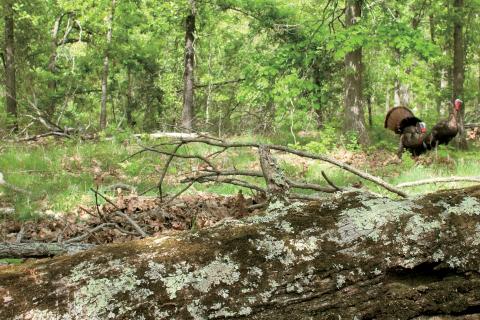
These Turkey Decoy Tips Will Help Ensure A Successful Harvest
Ask experienced hunters what they think of turkey decoys, and you're likely to get reactions ranging from full endorsement to complete rejection.

The reality of using decoys is somewhere in-between those two extreme beliefs.
Success with decoys varies greatly, and from early to late season. Hunting pressure, and lack of it, also determines how well toms are duped by decoys.
But the following factors should be taken into account when using decoys.
Tip: The Avian-X LCD Strutter turkey decoy was created with incredible detail and lifelike realism, the LCD (Lifelike Collapsible Decoy) is 15% smaller than a real turkey, making it less dominant in the field and therefore more effective in attracting gobblers.
Set Your Decoys in a Highly Visible Spot
Don't call turkeys aggressively until decoys have been set in a highly visible spot, because you don't want a tom to show while you're adjusting dekes. It's best to pinpoint toms with locator calls, like owl hoots or crow calls, or even with binoculars, then deploy decoys, settle into a blind, and begin turkey calling to draw birds close.
This way a gobbler won't show up to hen yelps before decoys are set, and you're waiting with shotgun ready.
Turkey Decoys Must be LifeLike

Never hunt with old, worn, over-used decoys that have paint faded or bodies dented, cracked or broken. Hollow, foam decoys fold and carry easily, but they must expand back to their full-body, realistic shape without looking fake. The oldest, wisest gobblers got that way by surviving all predators, including hunters. Decoys must look like real birds.
Decoys are available in a wide range of prices, and many are not expensive, especially in the grand scheme of hunting costs these days. So if your decoys are looking a bit long in the tooth, get new ones.
Tip: The RedHead Foam Turkey Decoy 3-Pack includes lightweight, collapsible molded bodies have HD foam construction, which provides greater definition for ultra-lifelike painted feather detailing. Includes everything you need to create the perfect flock to attract a wary tom
Set Blind Position for Decoys
Count on turkeys doing the unexpected when coming into decoys. Don't trust that birds will walk in from the direction you predict. Be sure a hunting blind is well camouflaged to the sides, and rear, and be certain to have a number of open shooting lanes in all directions to ambush birds as they walk toward decoys. Remember the biggest boss gobblers often come in quietly. Stay alert, and still.
Number of Jake Decoys Set Out

Turkey Decoy
Experienced hunters say to use only one jake decoy in a set, since even the biggest gobbler is suspect of several jakes ganging up on him, especially if a gobbler has hens in tow that jakes want to steal.
Jakes often flock together in spring, pushed into young bachelor groups by big toms. A few jakes working together can give a tom all the fight he can handle, so big toms might steer clear of multiple jakes.
But a tom can handle one jake, and a lone jake decoy could pull him into shotgun range.
Tip: Bring gobblers into range fast by triggering their dominant instincts with the apprehensive posture and size of a young jake.The RedHead Crazy Jake won't intimidate a subordinate 2- or 3-year-old gobbler. And with a head, body and wing posture in 3/4-strut position, the Crazy Jake's posture tells any adult gobbler that this adolescent is nervous and ready to tuck his tail and run.
The Gobbler Decoy Strategy
A full-strutting boss gobbler decoy late in the season might not draw a 2-year old tom into shotgun range. Often, younger 2-year-old toms have been so beaten down by older, larger and tougher toms, when they see a big bird in strut they turn tail and run away. However, early in the season when the biggest toms are vying for breeding hens, a full-strut gobbler decoy can dupe the oldest birds on a roost.
- 10774 views

